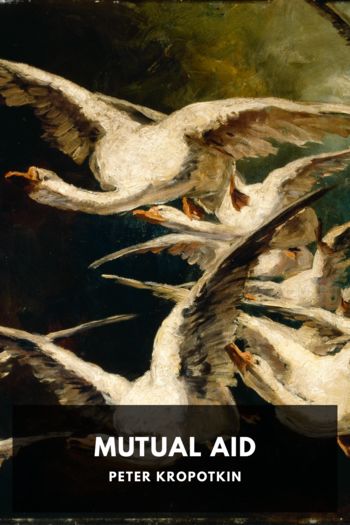Mutual Aid, Peter Kropotkin [fiction novels to read .txt] 📗

- Author: Peter Kropotkin
Book online «Mutual Aid, Peter Kropotkin [fiction novels to read .txt] 📗». Author Peter Kropotkin
The results of that new move which mankind made in the medieval city were immense. At the beginning of the eleventh century the towns of Europe were small clusters of miserable huts, adorned but with low clumsy churches, the builders of which hardly knew how to make an arch; the arts, mostly consisting of some weaving and forging, were in their infancy; learning was found in but a few monasteries. Three hundred and fifty years later, the very face of Europe had been changed. The land was dotted with rich cities, surrounded by immense thick walls which were embellished by towers and gates, each of them a work of art in itself. The cathedrals, conceived in a grand style and profusely decorated, lifted their bell-towers to the skies, displaying a purity of form and a boldness of imagination which we now vainly strive to attain. The crafts and arts had risen to a degree of perfection which we can hardly boast of having superseded in many directions, if the inventive skill of the worker and the superior finish of his work be appreciated higher than rapidity of fabrication. The navies of the free cities furrowed in all directions the Northern and the Southern Mediterranean; one effort more, and they would cross the oceans. Over large tracts of land well-being had taken the place of misery; learning had grown and spread. The methods of science had been elaborated; the basis of natural philosophy had been laid down; and the way had been paved for all the mechanical inventions of which our own times are so proud. Such were the magic changes accomplished in Europe in less than four hundred years. And the losses which Europe sustained through the loss of its free cities can only be understood when we compare the seventeenth century with the fourteenth or the thirteenth. The prosperity which formerly characterized Scotland, Germany, the plains of Italy, was gone. The roads had fallen into an abject state, the cities were depopulated, labour was brought into slavery, art had vanished, commerce itself was decaying.238
If the medieval cities had bequeathed to us no written documents to testify of their splendour, and left nothing behind but the monuments of building art which we see now all over Europe, from Scotland to Italy, and from Gerona in Spain to Breslau in Slavonian territory, we might yet conclude that the times of independent city life were times of the greatest development of human intellect during the Christian era down to the end of the eighteenth century. On looking, for instance, at a medieval picture representing Nuremberg with its scores of towers and lofty spires, each of which bore the stamp of free creative art, we can hardly conceive that three hundred years before the town was but a collection of miserable hovels. And our admiration grows when we go into the details of the architecture and decorations of each of the countless churches, bell-towers, gates, and communal houses which are scattered all over Europe as far east as Bohemia and the now dead towns of Polish Galicia. Not only Italy, that mother of art, but all Europe is full of such monuments. The very fact that of all arts architecture—a social art above all—had attained the highest development, is significant in itself. To be what it was, it must have originated from an eminently social life.
Medieval architecture attained its grandeur—not only because it was a natural development of handicraft; not only because each building, each architectural decoration, had been devised by men who knew through the experience of their own hands what artistic effects can be obtained from stone, iron, bronze, or even from simple logs and mortar; not only because each monument was a result of collective experience, accumulated in each “mystery” or craft239—it was grand because it was born out of a grand idea. Like Greek art, it sprang out of a conception of brotherhood and unity fostered by the city. It had an audacity which could only be won by audacious struggles and victories; it had that expression of vigour, because vigour permeated all the life of the city. A cathedral or a communal house symbolized the grandeur of an organism of which every mason and stonecutter was the builder, and a medieval building appears—not as a solitary effort to which thousands of slaves would have contributed the share assigned them by one man’s imagination; all the city contributed to it. The lofty bell-tower rose upon a structure, grand in itself, in which the life of the city was throbbing—not upon a meaningless scaffold like the Paris iron tower, not as a sham structure in stone intended to conceal the ugliness of an iron frame,





Comments (0)